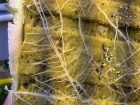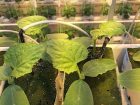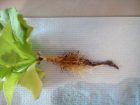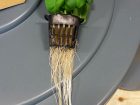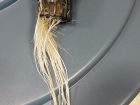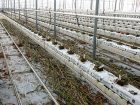
Features
Crop Culture
Inputs
The Many Root Causes of Production Woes
Well-Managed Root Zones are an Asset to Greenhouse Crops while Those Poorly Managed are a Liability
March 13, 2017 By Dr. Mohyuddin Mirza
March April 2017 – Writing about root zones for greenhouse crops has been an important subject for me and I have written a number of articles on this subject in Greenhouse Canada.
In the October 2016 issue I emphasized the importance of climate conditions in influencing root zone environment. Since roots and root zones are the foundation of the entire crop, I keep on reminding growers about this subject.
In this issue I am going to share many pictures with you and explain what the plants are trying to tell us.
I am seeing different types of roots especially in indoor farms where plants are grown in water enriched with nutrients.
Photo A: I recently took this picture from a floating hydroponics unit and was pleased to see nice white roots with lots of root hair. The tops of the plants were similarly very good – dark green and with no signs of any deficiency.
Root hair and the importance of oxygen: An abundance of root hair indicates good dissolved oxygen in the water. It is a well-established fact that solubility of oxygen depends on temperature. The maximum solubility of oxygen is at 4 C and is around 9 ppm. As the temperature rises to 20 C, the oxygen level drops to around 5-6 ppm. Root rot issues set in once it drops below 4 ppm. The damping off fungus pythium likes low oxygen levels for its growth and development.
My good friend Trevor Schriemer from Precision Produce Ltd. (Otterburne, Manitoba) loves to look at roots and shares the photos with me to comment on.
Photo B This is a picture he sent in January of his cucumber seedlings. Notice how strong and visible the root hairs are. These root hairs absorb water and nutrients and transport them to the leaves via water conducting tissue of xylem.
NICE, WHITE ROOTS INDICATE GOOD TOP GROWTH
Most of the observations on roots are visual. Nice, white roots are an indication of good top growth of the plants.
Photo C: This photo, also sent by Trevor, shows the top growth of cucumber seedlings. It is my practice to turn a rockwool block upside down and look closely at the roots. Root tips, especially, provide very good information on efficient absorption of water and nutrients.
If root tips are brown, then it could be an indication of the start of an attack by the fungus pythium. As mentioned earlier, this fungus reduces the uptake of water by destroying the root hair. It appears that once this fungus attacks the roots, the plant begins to “fight back.” Photo D highlights the point I want to make. It was taken from a hydroponics lettuce production unit. A “fight” is going on between pythium and the plant defence system. The roots are rotten on the lower part and the plant is producing new roots above that.
I think in this case the grower was not helping these plants. You can see how the top growth is yellow, which indicates nutrient issues. If roots are not healthy and functioning, then deficiencies of various nutrients take place. The oxygen level in the nutrient solution was around 2 ppm, which is very low. In this case the root rot beat up the grower. A new crop had to be started, but first the system had to be cleaned up and water disinfection measures introduced before healthy lettuce production was started.
With the increased production of herbs and other crops in hydroponics system, the physics of root growth is important. Photos E and F highlight the point I want to make. Photo E shows that more roots are coming out of the plug while in Photo F the roots are coming out of one side only. That was evident in the top growth.
Make every effort to have healthy root development and growth on seedlings. If the roots start intertwining and the seedlings are separated, then root damage can occur. Such seedlings with root damage during transplanting will show leaf edge burn very quickly.
Photo G is just to highlight that how hard the roots must work to transport water and nutrients on such long tomato vines. I once measured the length of these vines and found some were almost 45 to 50 feet long. So root health is not only important for seedlings in pure water-based systems but also in the growing media.
There is a theoretical calculation as well. Tomatoes produce three leaves and one set of flowers (clusters) per week and generally the length is around 12 inches. The size of the internodes depends on 24 hour-average temperatures and the difference between day and night averages. So if the average is one foot per week, then a 40-week-old tomato vine should be around 40 feet long.
I have an ongoing discussion with growers that our growing media volumes are decreasing per plant and thus lesser amounts of roots are developed to support the top growth of the plants.
Take the example of a tomato crop growing under LED lights I recently visited. Very severe leaf necrosis was noticed. It appears to be more severe than just edema, which is related to root pressure and leaf temperature and ramping from day to night. I also believe the root volume was far less than it should have been. I think we need to revisit proper growing volumes per plant so that optimum roots can be developed.
Feed EC and Leach EC go hand in hanD
I was reviewing leach nutrient analysis from a cucumber grower and making recommendations as to how much of leach should be combined with fresh solution. Recycling of water from the leach is practised by many growers in Canada. It is important to understand the dynamics of EC in the root zone.
What is an optimum leach percentage? I have seen growers leaching very heavily especially in summer, as high as 50 to 70 per cent. Basically, they are using nutrient solution to leach to maintain the desired electrical conductivity (EC). If the nutrient solution EC is 3.0, and leach EC is 4.0, then growers will increase the timing of dripper flow and thus hope to bring EC down to desired levels. My experience is that over 50 per cent maximum is too much leach volume. The growing medium gets saturated and that is an invitation to fungi such as pythium. Water-logged conditions may occur. I suggest to stay close to 20-25 leach percentage.
Why EC can go higher than the feed solution? Normally one should expect that the feed and leach EC should be the same or close in range. But it is never the case because plants can selectively absorb water under very high light conditions. When water is removed from the root zone through transpiration then the ions will accumulate in the growing medium.
I have also seen higher EC in the leach solutions because the growing medium – such as coir – was not flushed properly. Many growers buy pre-washed bags but they may not have been washed properly or according to your expectations. Washing of coir is done in bulk and then dried and put into pillow bags. So be aware of the reasons why EC is higher than the leach.
Can plain water be introduced during high light periods to bring EC down? Yes, when light levels are higher than 1500 joules then plain, pH adjusted water can be used and thus the proper EC can be maintained and managed.
Remember the higher the light, the lower will be the EC of both feed and the leach.
Dr. Mohyuddin Mirza is an industry consultant, drmirzaconsultants@gmail.com.
Print this page

